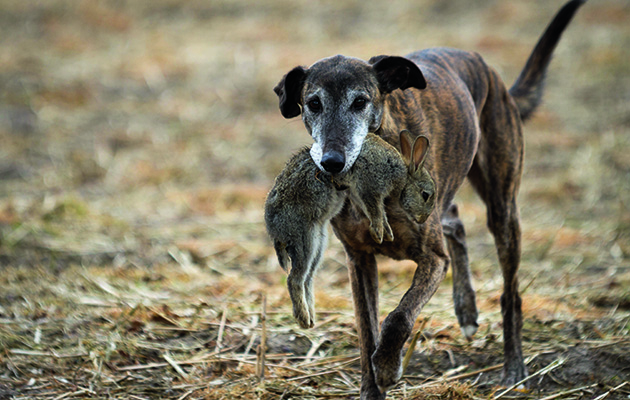Learning to love the lurcher

When I first met the Mister, he was used to shooting over his ferrets, while I worked them with a lurcher. Never were there two more conflicting ways to conduct the same discipline: he was convinced that a dog near the buries would lead to rabbits refusing to bolt, and I was afraid my ferrets would be shot. I used a dog to check if there were rabbits in the buries, and he used fieldcraft. I thought a dog was better, while he thought it would be a liability, likely to be off slaughtering deer and pheasants when not tied to a tree, or crunching the rabbit to bits if one did bolt despite the dog pushing its head down rabbit holes, not to mention the constant barking. He wasn’t convinced his ferrets would be safe from a mauling, either.
So he took me ferreting his way, using his ferrets because, after all, we’d only just met. I was pleasantly surprised, not only by his fieldcraft, but also by his safety consciousness. The ferrets were in no danger, and it was all rather restful with no netting up. We sat in a cleft on one hillside with the ferrets working buries on the other: safe backdrop and rabbits bolting nicely.
After the action stopped and the ferrets came out, we wandered down and picked up the rabbits we’d shot, then set off to the next bury, with no time lost collecting nets again. But when I wanted to show him my way, he told me he preferred to purse-net if he wasn’t shooting, and he didn’t want to know about the lurcher work. Being adults, we compromised by working different buries on the same hill.
A gentle dog
At the time, I had Worm, a lurcher of such apologetic and gentle demeanour that it was hard to believe she could ever catch anything. However, she was the perfect pot-filler, turning her paw to feather and fur of every sort, and adaptable over any country. She showed me a bury with rabbits present and I started setting nets, never doubting her ability, she was never wrong. Before long, we were extracting a steady tally of rabbits, the dog obligingly holding them in the nets until I could get to them. She was velvet-mouthed and never marked a rabbit in all her life.
After an hour or so, the Mister’s bury had yielded up its contents successfully with no help from a skinny cur, so he came round to see how I was doing. I suspect he was surprised at the neat line of cooling rabbits and the dog watching the bury quietly instead of crunching them or dragging them about. I offered to show him exactly what we did with the next bury, and he came along to humour me.
He watched Worm mark the bury, helped me set the nets, and frowned as the dog trod lightly around, testing the air at the rabbit holes but not scrabbling or snorting down them as he had thought she would. In went the ferrets and Worm backed off to one side of the bury, flicking her ears and flaring her nostrils as she felt the ferrets working below from vibrations under her feet, scenting and listening all the time. He could hardly contain his disapproval when she walked right across the bury to stand next to a rabbit hole, not pushing her face at it, but surely she would scare any rabbit trying to bolt.
A fluffy face peered cautiously out of the rabbit hole: the dog froze. The rabbit hopped once and paused, feeling the net. Still the dog didn’t move. Then the rabbit launched itself and so did the dog: all the human eye could see was a dog standing still, and then a dog floating gently back to earth with a rabbit in its mouth.
I was used to this; he wasn’t. I took the rabbit, which the dog released straight away like good ferreting dogs do, and then we had two rabbits bolt from different holes. The dog caught one and I had the other. I was just disentangling the second net when another rabbit shot out of a pop-hole, and the dog, which had soundlessly arranged herself in exactly the right place, leaned forward and closed her jaws around it and then carried it back to me, her eyes glowing with pride. Once that bury was empty, the Mister helped me pick up the nets and box the ferrets while conceding that a dog could have its uses after all.
Stealing rabbits
Twenty years or so later, he is still a tad frosty about the early training of a ferreting dog where they do get it wrong until they have learned to stand off. We are now fielding Worm’s great-great grand-daughter, The Colly, every bit as much of an asset as her predecessors. We also shoot over ferrets without a dog when the land is more suitable for that.
But that first time had one more speciality of the running dog to teach him, and one that I had never trained Worm to do. Once we had finished with the bury, we went to get the rabbits to paunch them, and they seemed to have grown in number. This often happens when you get so involved in the bolting and re-netting that you lose track of how many you have caught. There isn?t a gun in the world, though, that can replicate a thieving lurcher.
We both realised at the same time what had happened, as Worm came round the hill carrying the last of the rabbits that the Mister had caught and left on the bury, awaiting his return. She stashed it with the ones we had caught together, gave us a lurcher’s grin, and wagged her tail.








